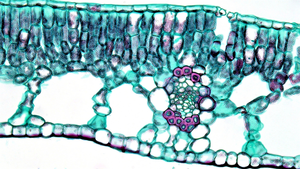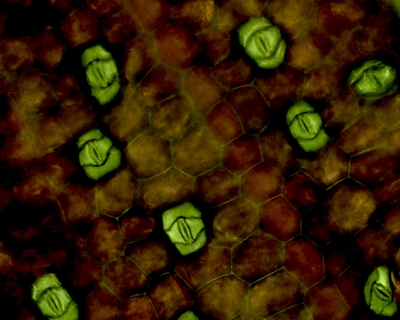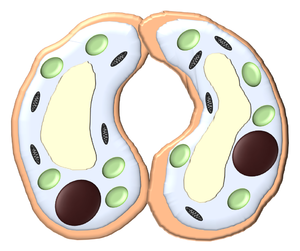Contents
Key Stage 3
Meaning

The two guard cells can be seen at the leaf.
A guard cell is a specialised cell in a plant leaf which can change shape to allow or stop gases from getting into the leaf.
Adaptations of the Guard Cell
- Guard cells can change shape to open and close a hole called a stoma.
| The under side of a leaf showing guard cells and stomata. |
About Guard Cells
- Guard cells are shaped with a gap between them called a stoma.
- There are more guard cells found on the bottom of the leaf.
- Photosynthesis needs water, so guard cells are there to make sure the leaves don't use up too much water and die of dehydration.
- Guard cells fill with water to become turgid, making the stomata larger. This allows carbon dioxide into the leaf for photosynthesis.
- When the leaf gets dehydrated the guard cells become flaccid making the stomata smaller. This stops carbon dioxide from getting into the leaf and prevents photosynthesis
| Turgid guard cells are full of water and have a hole called a stoma between them to allow air in and out. | Flaccid guard cells are dehydrated and the stoma is blocked stopping air form getting in or out of the leaf. |
Key Stage 4
Meaning
A guard cell is a specialised cell in a plant leaf which can change shape to open or close a hold in the leaf called a stoma allowing or preventing gas exchange.
About Guard Cells
- Guard Cells are essential to control the rate of photosynthesis and transpiratation.
- When guard cells become flaccid, due to dehydration, the stomata close and water vapour can no longer escape the leaf. This stops transpiration, preventing further water loss. The closed stomata also prevent Carbon Dioxide from entering the leaf, stopping photosynthesis and conserving water (which is needed for photosynthesis.


